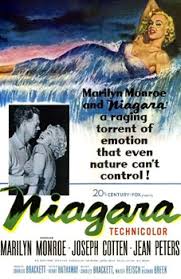
George Loomis (Joseph Cotton) is a troubled man. George has spent some time in a mental hospital due to his service in Korea. His wife Rose (Marilyn Monroe) is younger, beautiful, and quite sexy. Men’s heads turn when she walks by. Along with his depression George has bouts of jealousy. George and Rose are spending some time in Niagara Falls at the Rainbow Cabins so George can relax.
Ray Cutler (Max Showalter) and his wife Polly (Jean Peters) have just arrived in Niagara Falls. They have been married for three years and are at the falls as a delayed honeymoon. They are also staying at the Rainbow Cabins. They are scheduled to occupy the same cabin that the Loomises are in. Rose tells them about her husband’s condition so Ray and Polly take another cabin.
Later at the falls Polly sees Rose kissing a young handsome man. He is Rose’s lover Patrick (Richard Allan). As the couples begin to get to know each other Polly sees that George has mood swings. There are some young people playing music and dancing outside their cabin. Rose goes out dressed in a revealing red dress and asks them to play a particular record. The song “Kiss” has special meaning to her, something that is not lost on George. In a rage he goes out and breaks the record into pieces cutting his hand. Seeing that George is injured Polly goes over to his cabin to dress his wound for him. George, now depressed, relates to her some of his troubles.
Now that Rose has established that George is not quite right she tells her lover that it is the right time to kill George and make it look like he either jumped or fell into the falls. To let Rose know that the deed has been done he says he will have the Rainbow Tower Carillon play Rose’s song “Kiss”. Rose lures George to the tourist tunnel. Patrick follows. Later as Rose is pretending to be worried that her husband is missing she hears the carillon play.
The body is found and taken to the morgue. Rose goes to identify it as George. What she sees is not George but Patrick. Rose collapses to the floor. She is taken to the hospital and is sedated. While in a drugged stupor Rose hears the carillon play “Kiss”. George is up to something, and Rose is not going to like it. Time for some psychological revenge.
“Niagara” was released in 1953 and was directed by Henry Hathaway. It is a thriller and a film noir. Normally noir films are in black and white. “Niagara” is in color but it still has the other major noir aspects. The shading, lighting and creative camera angles are present. The tension and suspense are also a major part of the film. It also has crime, jealousy, the woman in peril, adultery, the femme fatale, and all with the beautiful backdrop of Niagara Falls. The falls itself is almost a character.
“Niagara” was one of the last films done in 'three-strip' Technicolor by Twentieth Century-Fox. Not too long after the film was done Fox switched to Cinemascope.
There are four main characters in the film. None of them are all that lovable. Rose, of course, is the nasty one who married for money. Now that her husband doesn’t have any she wants a younger stud and is willing to kill to get him. George is the character you at first feel sorry for except for the fact that he was dopy enough to marry a sexy toy and think that she really loved him. Then when he realizes Rose wants him dead he focuses all that battle fatigue on her. Polly is the closest to being the innocent victim, and/or hero of the story. She finds out that George is alive but waits to tell the police about it. It seemed a little passive/aggressive to me. I know that she felt sorry for George and wasn’t impressed with Rose but holding her tongue put Rose in jeopardy. Ray I hated the most of the four. When Polly tells him about seeing George and that he wants to kill Rose, instead of listening to her he acts as if she is a typical hysterical woman that was imagining things and just needed a nap. Besides being a jerk he had this “I know best dear” attitude which firmly illustrated that his wife had more brains than he did. The rest of the time he was annoying and whiney.
Although “The Asphalt Jungle” 1950 was the first film in which Marilyn Monroe became well known, “Niagara” was the one that jettisoned her into star power. Even though she was top billed in the film she was still under contract as a stock actor so her salary was scale. The famous walk by Marilyn's character Rose Loomis across the cobblestone street holds the record for the longest walk in cinema history, 116 feet of film.
Despite being a sex object that got men firmly into theater seats, Marilyn was, as the diabolical Rose, really good. She was gorgeous and evil, sexy and calculating. She may have been a sex symbol but to dismiss her as just that is irresponsible. Her performance as Rose Loomis was the embodiment of the definition of femme fatale.

